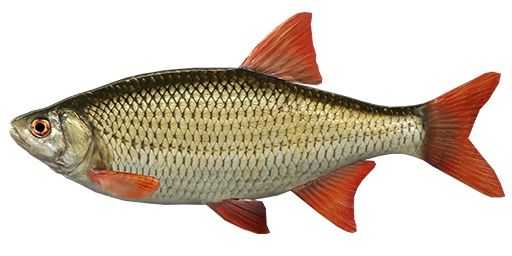Rudd

Species Details
Scardinius Erythrophthalmus
Cyprinidae
Cypriniformes
Lake, River, Backwater
2 - 5 lbs.
14" - 24"
Rudd (Scardinius erythrophthalmus) Fish Description
The common Rudd, or otherwise known as a Pearl Roach, has bright red pectoral, pelvic, and anal fins. However, the Rudd’s dorsal and tail fins appear to be more of a brown to bright red gradient. It appears to be a stocky and deep-bodied fish with a slightly protruding lower lip. The tail fin is a bit forked, forming a deep letter “v”. While the Rudd appears to be silvery-white, the top (dorsal) portion of its body appears to be dark olive green.
While they do look like a Minnow, they can be told apart by their scaled keels. These look like a line between their pelvic fins. However, the Rudd looks more similar to the Golden Shiner and requires a closer look to tell them apart. To tell them apart, one has to count the number of rays on their fins. Rudds have around 9-11 rays for their dorsal fin and 10-11 for their anal fins. Also, to take note more of the color on their fins. The Rudd’s fins are red whereas the Golden Shiner has golden fins.
Rudd Diet and Size
When young, Rudds are carnivorous. They eat smaller fish and aquatic insects. Sometimes, they also feast on zooplankton. However, as they grow older, Rudds become vegetarian and prefer aquatic plants as their main source of nutrients.
Rudds grow to an average of 25 cm but have been reported growing to 45-50 cm.
Interesting Facts about the Rudd
- Rudds are considered an invasive species especially when they breed with a Golden Shiner.
- Adult Rudds are usually responsible for the destruction of vegetation that other fish use as their habitat.
- Some people have used Rudds as baitfish.
- It’s illegal to keep or buy Rudd.
- Anglers are often instructed that if they do keep a Rudd, it’s best to kill it.
- Some people do keep its hybridized version, the Golden Rudd.
- Rudds are not picky about water. They can adapt anywhere even if the water is of poor quality.
- An average Rudd’s lifespan is around 17 years.
- Rudds eat a lot! They eat up to 40% of their body weight.
- Rudds are different from Roaches. The best way to tell is the position of their lip. Roaches are bottom feeders whereas Rudds like to feed on the surface.
Rudd – Fishing Techniques: How to Fish for a Rudd
Choice of bait when fishing for a Rudd can either be casters (the pupae form of maggots), bread, sweetcorn, and small boilies. But that’s if you’re attracting young ones. However, adult Rudds do prefer vegetation so leaving a weighted plant-based bait might help.
Rudds are known to give anglers a problem because of their finicky nature and that they destroy the habitat of other gamefish. Unlike other fish, they can detect if there’s something wrong or not. This is why some people recommend just letting the bait float at the surface. Because Rudds are surface eaters, they are more prone to attacking the bait if it’s just floating above the water.
For set-up, some recommended making a cloud in the water. Anglers usually do this by throwing in some milk in the water. And especially, if it’s bright out. Rudds are more cautious when there’s bright sun. So, either create a cloud to lower the amount of light or fish at dusk where they’re more aggressive and active.
Most of all, find water bodies with a lot of vegetation. Adult rudds love aquatic plants so the more aquatic plants there, the higher the chances they’ll be there.
Rudd Habitat and Distribution
Rudds are pretty tenacious as a species and can survive in all sorts of places. They are not seen in open water but they are currently in Lake Ontario. Or better yet, look for streams and paddies with a lot of vegetation. Some say that reeds and horsetails are a good sign that they’re around there since rudds need a lot of plants in their diet.







